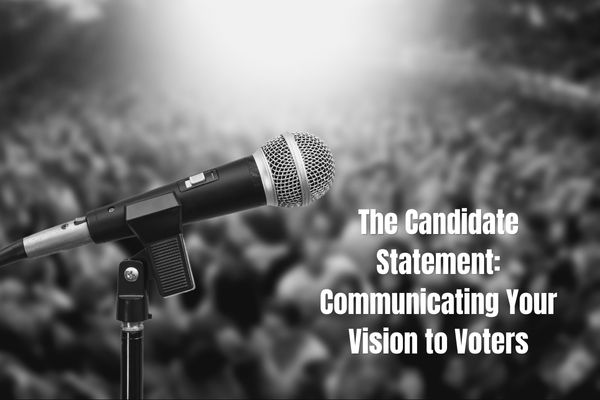

Who are you to voters? At the start of an election campaign, political candidates outline their positions on various issues. These are called candidate statements, and they are used to help voters make informed choices. In this article, we will explore what a memorable candidate statement is and the key elements you need to write one.
Let’s start with the most obvious question:
A candidate statement is an outline of a political candidate’s qualifications. It summarizes their positions on key issues, and their plans for the future. It’s more like a stump speech, as a statement is designed to be straight to the point, and connect with voters on a personal level.
Think of it as a voter introduction.
Versions of this information may be eventually reworked and included in voter information guides, campaign websites, and brochure material.

Writing a candidate statement isn’t as hard as you think.
When writing a candidate statement, the final result should easily provide voters with an understanding of the candidate’s background, platform, and vision. Just like a candidate’s personal bio, your statement should be concise and highlight your unique skills and values.
An effective candidate statement should include the following elements:
Your introduction should be concise and clear. It should outline who you are and what office you are running for. Then go into a short background description, while highlighting your unique qualifications for the elected position.
For example, you can mention how growing up in the local area gives you a unique perspective on how you can help improve the lives of residents today.
For example, you could say something like. “I was fortunate to have grown up in our vibrant community. It’s this very upbringing that instilled in me the values and understanding that make me qualified for mayor. My roots in this area have given me insight into the challenges we face, as well as the opportunities that lie ahead.”
The background section should be all about your education, work experience, and other relevant accomplishments. Provide context so voters can better understand how your experience and skills directly relate to the position you seek.
For example, suppose you are running for sheriff of a county, and an important election issue is that of community policing. You have a law enforcement background and worked as a community outreach officer. This makes you well-qualified to address the issue. So, when drafting your candidate statement, you might highlight your specific qualifications, such as:
By focusing on these qualifications, you’ll show voters that you have the experience and skills to handle the role of community policing.
This section is perhaps the most important, as it is where you outline your positions on the issues. Highlight the most pressing issues that your voters are facing. Break down your platform into a concise, informed, and well-organized summary. For each issue, provide details on policy solutions or initiatives that you plan to implement if elected.
Finally, finish up with a summary of your main points. And don’t forget to add a clear call to action. Typically, this will be a request for your audience to support the campaign, to donate, volunteer, or get involved in some other way. Deliver your conclusion with confidence and conviction, so you leave a strong impression on the audience.
“Our community is at a crossroads. We have challenges, but also opportunities. We have to work together to make a difference. To do that, I need your support this November. Only then can we shape a better future for our city.”
Before you start writing your statement, you’ll need to do some research and preparation. Here are key elements of this process:
Overall, a well-crafted candidate statement can make a big difference in your political campaign. It can help establish credibility and build support for your election.